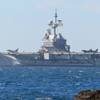BP's new fleet of oil tankers, already dogged by cracked rudders and missing anchors, now has a new glitch.
Fleet managers have been forced to replace deck fixtures called mooring bitts on three of four ships after tests showed they were defective and one violently broke down.
Mooring bitts are stout metal posts around which ropes are lashed for tugging on ships or securing them to a dock.
On Sept. 12, the tanker Alaskan Navigator was approaching the dock in Valdez when a bitt on the starboard bow broke off as a tug boat pulled on a mooring line, according to people with the U.S. Coast Guard, the ship's operator and a Valdez-based oil-industry watchdog group.
When it broke, the heavy iron bitt shot over the side of the ship and plunked into the water.
Fortunately, no one was in the way when the bitt broke loose, said Cmdr. Michael Gardiner, captain of the port for the Coast Guard in Valdez.
The ship's operator, Alaska Tanker Co. of Beaverton, Ore., used X-rays and other tests to determine that the failed bitt plus dozens more on three ships were defective and needed to be replaced.
The bitt problem is the latest bobble for the new fleet of $250mdouble-hull tankers, the first of which began carrying North Slope crude oil to West Coast refineries in the summer of 2004.
In spring 2005, two of the ships -- built in a San Diego shipyard -- were laid up for weeks after cracks were discovered in their rudders.
And in December, two ships, including the Alaskan Navigator, each lost a 16-ton anchor -- they simply broke off -- as the tankers sailed across the rough Gulf of Alaska with loads of oil.
Managers with Alaska Tanker Co., whose ships carry oil exclusively for BP, said the rudders have been repaired and the anchors that cracked and fell into the sea have been replaced.
Anil Mathur, president of the tanker company, said the string of problems has been a disappointment. But he added that he believes the ships are fundamentally safe.
The new double-hull ships built by another oil company, Conoco Phillips, don't seem to be having the same kind of problems, he said.
The oil companies were required to replace their single-hull oil tankers with double hulls after the Exxon Valdez oil spill in Prince William Sound in 1989. Today, the shipping revolution is all but complete as most every ship now calling on Valdez has a double hull, a feature believed to reduce the risk of a catastrophic release of oil should, for example, a ship run aground on rocks.
In BP's defense, Devens said the company under federal law had to build its new ships in a U.S. shipyard and those yards don't have the same experience or modern construction techniques as much busier Asian yards.
The mooring bitt broke despite being rated to handle considerably more force than the tug was applying to it. An investigation found that the cast mooring bitts on three ships were too weak to remain in use, while the fabricated bitts on the fourth ship were OK.
Mooring bitts are mounted all along the decks of the 941-ft. tankers.
Twelve key mooring bitts on three ships have been replaced, but ultimately about 74 will be replaced
An Alaska Tanker Co. e-mail provided by the Regional Citizens' Advisory Council detailed an unexpected engine shutdown on the Alaskan Navigator -- the same ship that lost the mooring bitt -- as the vessel left the dock Nov. 28 at Cherry Point, Wash.
The vessel was not in danger and the source of the problem was fixed, the e-mail says. Afterward, the company set a new policy that any maneuvering tanker must have at least three of its four engines running, not just two.
Source: Anchorage Daily News
Subscribe for
Maritime Reporter E-News
Maritime Reporter E-News is the maritime industry's largest circulation and most authoritative ENews Service, delivered to your Email five times per week









